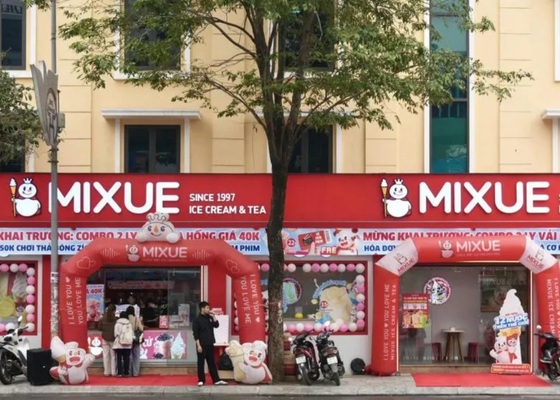Eating Chinese soft power
Isabelle Chua analyses the rapid expansion of Chinese food brands, highlighting how this trend has become an informal yet influential form of Chinese soft power in Southeast Asia.
21 July 2025

A few years ago, Chinese chain Mixue exploded across Southeast Asia. Selling incredibly affordable ice cream and sweetened drinks, Mixue has beaten chains like Starbucks and McDonald’s in the number of outlets opened globally. All major Southeast Asian markets have seen a rapid expansion of distinctly Chinese supermarkets and food outlets in the past five years – Indonesia, Malaysia, Thailand, and Vietnam, in particular.
The past decade has seen a shift in the share of food imported from China into Southeast Asia and its constituent economies compared to Southeast Asia’s total amount of imports – from 8.5 per cent in 2010 to 10.9 per cent in 2020. Over the 2010-2022 period, the strongest shifts in Chinese import share, as compared to all food imports, were observed in the Philippines (4.0 per cent), Thailand (5.1 per cent), and Singapore (1.8 per cent).
The increase in two-way trade could be partly attributed to preferential rates for Chinese products and services, including agricultural products negotiated under the ASEAN-China Free Trade Area in 2002 and subsequently in the Regional Comprehensive Economic Partnership. Chinese businesses leveraged these agreements and targeted these large markets. In the Philippines, Chinese products and social media trends have gained popularity among the youth, despite China’s negative reputation. Some have blamed this on the Chinese government’s efforts to recruit Filipino social media influencers and astroturfing more generally, but it could also just as easily be a separation of state behaviour from cultural practices.
Aside from increased imports of food products, though, Chinese branding is more visibly present through packaging labels and the presence of Chinese food and beverage (F&B) chains. There is some effort to push Chinese F&B brands in Southeast Asia. According to a 2025 report by Momentum Works, there are at least 6,100 Chinese F&B outlets across the region, concentrated in over 60 brands. This expansion reflects the intense competition within China’s domestic F&B sector, which drives many chains to seek opportunities abroad. Chinese chains reportedly occupy 54 of the top 100 global F&B chains ranked by number of outlets, and among those, many have outlets in Southeast Asia (Table 1).
These chains often cluster in areas with large ethnic Chinese communities or strong historical ties to Chinese culture – most notably in Singapore. However, some in China argue that Singapore’s small market is already oversaturated. Nevertheless, the expansion to Singapore and Southeast Asia more broadly is still necessary. Over a million F&B outlets closed their doors in China during the first half of 2024 due to China’s weak consumption. The low prices that Chinese F&Bs offer in Southeast Asia reflect the cut-throat competition they face at home.
Many studies on soft power tend to emphasise its role in shaping another culture’s values – an influence often manifested spatially and visually through the transformation of cities and their urban landscapes, for instance. Food is one vector of cultural transmission, although often underrated. The McDonald’s that stood on Red Square, Moscow, after the fall of the Soviet Union remains a powerful image, much like the early arrival of Western fast-food chains in Southeast Asia, which helped shape popular perceptions of the West. Just as the food cultures of the West influenced China’s culture during its period of opening up, youth cultures of Southeast Asia are now being shaped by the widespread availability of cheap, tasty snacks with Chinese characters all over them.
A broader strategy to counter Western cultural influence is clearly underway, both within China and its neighbouring countries, aimed at advancing China’s strategic interests by strengthening “National Cultural Soft Power”. Chinese food is increasingly prominent in the social media feeds of Southeast Asian youth, not entirely without nudging by state institutions. The quality of a nation’s products is not the only determinant of its image, though, and it is clear that state guidance has been put to much better use focusing on other aspects of public diplomacy. Similarly, it is likelier that public displeasure with China in Southeast Asia arises from Chinese foreign policy rather than lacklustre food exports. Thus, one should not overestimate China’s role in the expansion of Chinese food brands. It is primarily economic factors that drive this trend.
Repeated interactions with reliable Chinese brands do improve the country’s image among Southeast Asian youth, in a sort of accidental, “inverse” country-of-origin effect. Instead of positive perceptions of national branding driving the choice for specific products associated with that nation – think Swiss watches explicitly advertising their Swiss association, a classic example of the country-of-origin effect – there have been some cases of product quality enhancing the perceptions of the country instead, hence “inverse”.
Helpfully for China, the brands themselves take active steps to capture the hearts of consumers, with the aforementioned Mixue working hard to retain the confidence of Muslim consumers in its compliance with halal certification. The effort to integrate demonstrates that these brands are not only appealing to the low-hanging fruit of large Chinese diaspora communities across the region but also attempting to assimilate to the local context in which they operate.
As prevalent as they are, there is still a mistrust of Chinese consumer products in Southeast Asia. There is a negative country-of-origin association with Chinese products that has dampened over time but persists partially because of several high-profile scandals. Within the agri-food industry alone, beyond the melamine-tainted milk incident of nearly two decades ago, Southeast Asian traditional and social media often reshare cases like the ongoing fight against gutter oil that are framed as emblematic of China’s broader difficulties with enforcing food safety guidelines. The normalisation of soft power influence through cultural diplomacy can only go so far, and the inverse country-of-origin effect often is unable to overpower the country-of-origin effect.
There should be concerns around a backlash if highly cost-competitive Chinese F&B chains outcompete and crowd out smaller local chains and small establishments, paralleling the existing wariness around the dumping of excess Chinese production capacity into ASEAN markets. To upset locals, it may not necessarily matter whether the sudden explosion of Chinese chains all over their towns is a result of state-led efforts to expand China’s cultural influence or simply the result of economic factors influencing private sector decisions.
Furthermore, evidence suggests that when political tensions flare between nations, it is the most publicly exposed businesses and products, like F&B chains, that will receive negative attention. Accidental slip-ups, like drawing the nine-dash line on a map of the South China Sea (see: Chagee in Malaysia and Vietnam), draw negative attention and pressure on chains that are then caught between the foreign policies of the states they originate from and operate in. This principle also applies to non-Chinese brands. McDonald’s and Starbucks suffer boycotts in Southeast Asia’s Muslim countries, but we hear no similar actions against US companies selling manufacturing equipment or business-to-business software-as-a-service.
Ultimately, current trends already indicate that the food trade between ASEAN and China will only continue to increase alongside all other forms of economic integration. An ever-increasing proportion of Southeast Asian youth watch Chinese media, sing Chinese songs, use Chinese social media, play Chinese games, and enjoy Chinese flavours. Being steeped in an increasingly Chinese environment brews a familiarity with China that legitimates its stronger regional presence. Southeast Asians should be prepared to see more Chinese chains on their streets – although it is uncertain whether this will really help or hurt China’s image here.
Isabelle Chua is a Research Officer with the Regional Economic Studies at ISEAS – Yusof Ishak Institute.
This article was first published on Fulcrum on 9 July 2025.
Image: A photo of a Mixue store in Hanoi, Vietnam. (Photo by Mixue Vietnam via Facebook)
How can we help? Get in touch to discuss how we can help you engage with Asia
